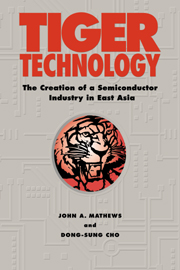Book contents
- Frontmatter
- Contents
- List of Figures
- List of Tables
- Preface
- Abbreviations
- Introduction
- Part I The ‘Real’ East Asian Miracle
- Part II National Institutional Pathways
- Part III The Technology Leverage Strategy
- 6 East Asian Semiconductor Industries: National Strategies and Sustainability
- 7 Limits to Technology Leverage Strategies
- 8 National Systems of Economic Learning: Lessons from East Asia
- Appendix I Exchange Rates: 1975–97
- Appendix II Chronolog
- Glossary
- Bibliography
- Index
7 - Limits to Technology Leverage Strategies
Published online by Cambridge University Press: 09 October 2009
- Frontmatter
- Contents
- List of Figures
- List of Tables
- Preface
- Abbreviations
- Introduction
- Part I The ‘Real’ East Asian Miracle
- Part II National Institutional Pathways
- Part III The Technology Leverage Strategy
- 6 East Asian Semiconductor Industries: National Strategies and Sustainability
- 7 Limits to Technology Leverage Strategies
- 8 National Systems of Economic Learning: Lessons from East Asia
- Appendix I Exchange Rates: 1975–97
- Appendix II Chronolog
- Glossary
- Bibliography
- Index
Summary
This chapter probes the strengths and weaknesses of the model of high-technology industry creation through leverage, and the underlying conditions that account for the industry's success or failure. We have shown in previous chapters that Korea, Taiwan, Singapore and, to some extent, Malaysia have mastered leverage strategies for the creation of high-technology industries, in particular semiconductors, while similar strategies appear to be working well in other countries of the region, notably China.
But how effective have these strategies really been? They may have created viable and well-balanced semiconductor industries that are capable of sustaining themselves, but have they worked in other sectors and cases? Is there a coherence in their repeated applications? Are there counter-examples? How widespread is their applicability? Is their success, such as it is, contingent on certain industry characteristics? Is a leverage strategy more likely to work in one kind of industry than another? We aim, then, to look at the leverage strategies to find out how and why they work. We also seek to establish the extent to which they are spreading and why.
There are three cases to consider: further leverage in the same core countries of East Asia as they continue to upgrade their knowledge-intensive industries; leverage by other countries in East Asia such as China; and leverage by advanced firms in the technologically advanced countries. We shall look for evidence of coherent application of leverage strategies in all three cases in order to establish their significance.
- Type
- Chapter
- Information
- Tiger TechnologyThe Creation of a Semiconductor Industry in East Asia, pp. 287 - 312Publisher: Cambridge University PressPrint publication year: 2000



